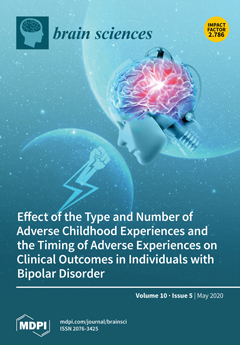Background: Negative psychological conditions are common in patients with cardiovascular diseases. Although depression has been scrutinized over the years in these patients, only recently has anxiety emerged as another important risk factor. The purpose of this study was to compare the parameters of
[...] Read more.
Background: Negative psychological conditions are common in patients with cardiovascular diseases. Although depression has been scrutinized over the years in these patients, only recently has anxiety emerged as another important risk factor. The purpose of this study was to compare the parameters of psychological stress in a population of coronary patients with and without myocardial revascularization procedures and to analyze lifestyle and socio-economic contributors to the state of health of these patients before inclusion in a comprehensive individualized rehabilitation program. Methods: This study included 500 patients with coronary artery disease (CAD) in stable condition divided in 2 groups: 200 patients who underwent coronary artery bypass grafting (CABG) or percutaneous transluminal coronary angioplasty (PTCA) (Group 1) and 300 patients without myocardial revascularization (Group 2) with stable angina or thrombolyzed myocardial infarction. The protocol included screening for anxiety/depression after procedure using three different scales: Duke Anxiety-Depression Scale, Hospital Anxiety and Depression Scale (HADS) and the Type D Personality Scale (DS-14) scale that evaluates negative affectivity (NA) and social inhibition (SI). Results: Significant differences between groups were observed for HAD-A (9.1 ± 4.18 for Group 1 vs. 7.8 ± 4.03 for Group 2,
p = 0.002) and DUKE scores (30.2 ± 12.25 for Group 1 vs. 22.7 ± 12.13 for Group 2,
p < 0.001). HAD-A scores (
p = 0.01) and DUKE scores (
p = 0.04) were significantly higher in patients who underwent PTCA vs. CABG. CAD patients without myocardial revascularization (Group 2,
n = 300) presented anxiety in proportion of 72.3% (
n = 217) out of which 10.7% (
n = 32) had severe anxiety, and 180 patients had depression (a proportion of 60%) out of which 1.3% (
n = 4) presented severe depression. The correlation between the presence of type 2 diabetes mellitus (T2DM) and type D personality in revascularized patients (
n = 200) was significant (Chi2 test,
p = 0.010). By applying multinomial regression according to the Cox and Snell R-square model and multivariate linear regression by the Enter method, we demonstrated that male gender, age and marital status proved significant predictors for psychological stress in our study population. Conclusions: The results obtained in this study provide a framework for monitoring anxiety, depression and type D personality in coronary patients before inclusion in comprehensive rehabilitation programs. Behavioral and psychological stress responses in patients with CAD significantly correlate with risk factors, and could influence the evolution of the disease. Moreover, other factors like gender, income and marital status also seem to play a decisive role. Evaluation of psychological stress parameters contributes to a better individualization at the start of these programs, because it allows adjusting of all potential factors that may influence positive outcomes.
Full article






